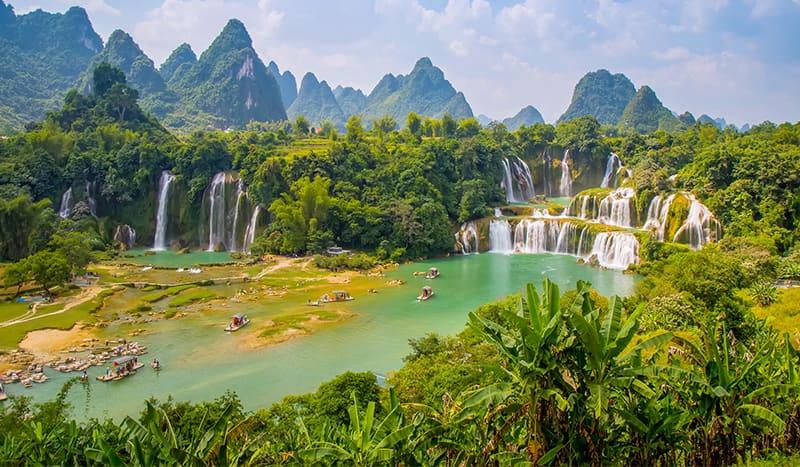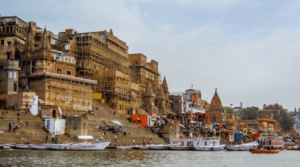India is a region of tremendous natural beauty, and its national parks are some of the most biodiverse and well-protected locations in the world. From the snow-capped slopes of the Himalayas to the lush rainforests of the Western Ghats, India’s national parks are home to a varied variety of wildlife, including tigers, elephants, rhinoceros, lions, leopards, and many bird species.
If you’re a wildlife lover, then India is the ideal spot for you to visit. Here are the top 10 national parks in India that you should add to your wish list.
India’s Top 10 National Parks
1. Jim Corbett National Park in Uttarakhand
Jim Corbett National Park is India’s oldest and largest national park, nestled in the valleys of the Himalayas in the Nainital region of Uttarakhand. It was formed in 1936 as Hailey National Park, and renamed in 1956 after Jim Corbett, a hunter, and activist who played a significant role in its development.
The park is residence to a diverse variety of wildlife, including Bengal tigers, leopards, elephants, rhinoceroses, deer, monkeys, and birds. It is particularly famous for its tigers and is home to one of the largest populations of tigers in India.
Jim Corbett National Park has five distinct zones: Dhikala for tiger sightings, Jhirna for challenging safaris, Bijrani for elephants and birds, Durga Devi for rhinoceroses, and Ramganga for diverse wildlife. Each offers unique scenery and animal experiences, from tigers and leopards to elephants and deer.
The ideal time to explore Jim Corbett National Park is from November to March (winter), with pleasant and dry weather. The park is open from April to June (summer), but it’s hot and humid. It’s Closed in the monsoon (July to September) due to heavy rain.
- Official Website of Jim Corbett National Park.

2. Valley of Flowers National Park in Uttarakhand
The Valley of Flowers National Park is a UNESCO World Heritage Site. It is a high-altitude valley nestled in the Himalayas and it is known for beautiful mountainous fields, bright flowers, and diverse plant species. The valley burst with breathtaking colors.
The park was formed in 1982 and it covers an area of 87.5 square kilometers. It is situated at an altitude of 3,600 to 4,400 meters above sea level and is surrounded by the hills of the Nanda Devi and Garhwal ranges.
The Valley of Flowers is a residence of around 600 types of flowers, including orchids, poppies, primulas, marigolds, daisies, and anemones. The flowers bloom from June to September, and the park is at its most colorful during this time.
In addition to its flowers, the Valley of Flowers is also home to a variety of other plant species, including trees, shrubs, and grasses. The park is also home to several animals, including the Himalayan tahr, the snow leopard, and the musk deer.
Here are some tips for visiting the Valley of Flowers National Park:
- Book your permits in advance. The park is very popular, and permits can sell out quickly.
- Be prepared for the altitude. The park is located at a high altitude, so you may experience altitude sickness.
- Wear comfortable shoes. You will be doing a lot of walking in the park, so it is important to wear comfortable shoes.
- Official website of Valley of Flowers.

3. Kaziranga National Park in Assam
Kaziranga National Park is a UNESCO World Heritage Site in the Golaghat and Nagaon districts of the state of Assam, India. It is famous for its big population of Indian one-horned rhinoceroses, as well as its diverse wildlife, including tigers, elephants, water buffaloes, and swamp deer.
The park is located in the Brahmaputra River floodplain, and its unique ecosystem is shaped by the annual flooding of the river. The floodwaters create a mosaic of grasslands, forests, and wetlands that are ideal for wildlife.
Kaziranga is home to two-thirds of the world’s population of Indian one-horned rhinoceroses. These rhinos are an endangered species, and Kaziranga is one of the most important places in the world for their conservation. The park also has a large population of tigers, elephants, water buffaloes, swamp deer, and many other species of animals.
The ideal time to visit Kaziranga National Park is in the dry season (November to April). This time animals are more active. However, the park is also open during the monsoon season (June to October).
- Official website of Kaziranga National Park.
4. Sundarbans National Park in West Bengal
Sundarbans is the biggest mangrove forest in the world and It is home to a wide diversity of animals. It has a distinct environment that is continuously evolving. The waves rise and fall twice a day, overflowing the forest and then draining it again.
The Bengal tiger is the most iconic animal of it. These large cats are solitary hunters that are perfectly adapted to the mangrove habitat. They can swim long distances, climb trees, and even walk on mudflats. The Bengal tiger is an endangered species, and the Sundarbans are one of the remaining areas where they can be found in large numbers.
Sundarbans are home to a variety of diverse animals, including crocodiles, snakes, monkeys, and birds. The park is also home to a rich marine ecosystem, with dolphins, sharks, and fish.
The Sundarbans National Park is a beautiful and fascinating place. It is a must-visit for anyone interested in wildlife, nature, or a unique cultural experience.
- Best time to visit: September-May
- Official Website of Sundarban National Park.
5. Gir National Park in Gujarat
Gir National Park is the only place in the world where the Asiatic lion (Panthera Leo Persica) is found in the wild. The park is located in the Girnar hills and covers an area of 1412 square kilometers.
The park’s dry deciduous forests, hills, and riverbeds provide a diverse habitat for a variety of animals, including lions, leopards, hyenas, jackals, foxes, wolves, sloth bears, nilgai, chital, sambar, chinkara, and four-horned antelope. There are also over 300 species of birds in the park, including peacocks, flamingos, pelicans, and eagles.
Here are some of the activities that you can do in Gir National Park:
Jeep safaris: The best way to see the lions and other animals in the park. Safaris are conducted in the morning and evening when the animals are most active.
Lion tracking: A more adventurous activity that allows you to get up close and personal with the lions. Lion trackers will use their knowledge of the lions’ behavior to track them down in the wild.
- Official website of Gir National Park.
6. Ranthambore National Park in Rajasthan
Ranthambore National Park is near the town of Sawai Madhopur. It is a former royal hunting site turned wildlife sanctuary. Covering 1,334 sq km in the Aravalli and Vindhya mountains and it has dry deciduous forests, grasslands, and lakes. Renowned for its tigers and the park houses diverse wildlife like leopards, sloth bears, and over 300 bird species.
Ranthambore National Park also has several historical and cultural attractions. Ranthambore Fort is a historical site. It was built in the 10th century. The fort offers stunning views of the surrounding countryside and is a popular tourist destination.
It is open from October to June, the best time to visit is November to February. It caters to researchers, tourists, and photographers.
Safari costs: It is vary by season and type, with jeep safaris ranging from INR 2,500 to 3,000 per person and canter safaris from INR 1,500 to 2,000.
- Official website of Ranthambore.

7. Periyar National Park in Kerala
Periyar National Park is a beautiful and biodiverse wildlife sanctuary situated in the Western Ghats of Kerala. The park is home to a wide diversity of animals, including elephants, tigers, leopards, sambar deer, and Nilgiri langurs. Periyar Lake is a major feature of the park, and it is a popular spot for boating and wildlife viewing.
The park is separated into two zones: the core zone and the buffer zone. The core zone is where most of the wildlife is concentrated, and it is closed to the public. The buffer zone is open to tourists, and it offers a variety of activities, such as boating, trekking, and nature walks.
One of the best ways to see the wildlife in Periyar National Park is to take a boat trip on Periyar Lake. The lake is home to a variety of animals, including elephants, crocodiles, and birds. You may also be lucky enough to see a tiger or leopard.
Another popular activity in Periyar National Park is trekking. Many trails wind through the forest, and you can often see animals such as elephants, deer, and langurs.
In addition to the wildlife, Periyar National Park is also home to a number of spice plantations. These plantations offer visitors a chance to learn about the cultivation of spices and to sample some of the delicious spices that are produced in the region.

- Official Website of Periyar National Park.
8. Kanha National Park in Madhya Pradesh
Kanha National Park is a UNESCO World Heritage Site located in the Mandla district of Madhya Pradesh, India. It is one of the most popular national parks in India and is known for its diverse wildlife, including tigers, barasingha deer, and over 200 species of birds.
The park is believed to be the inspiration for Rudyard Kipling’s famous novel, The Jungle Book. Kipling spent some of his childhood in India, and he is said to have been inspired by the sal forests, meadows, and iconic Kanha Plateau of the park when he wrote the novel.
Kanha National Park is a beautiful and exciting place to visit. It provides a range of activities that tourists can enjoy. If you are looking for a unique and unforgettable wildlife experience, then Kanha National Park is the perfect place for you.

- Official website of Kanha National Park.
9. Pench National Park in Madhya Pradesh
Pench National Park is situated in the southern part of Madhya Pradesh, bordering Maharashtra. It is a hilly area with an average elevation of 450 meters. The park is home to a variety of vegetation, including sal, teak, bamboo, and deciduous forests. The park is also home to a number of rivers and streams, including the Pench River, which flows through the park from north to south. The park is also known for its scenic beauty, with lush forests, rivers, and waterfalls.
- Official website of Pench National Park.
10. Mudumalai National Park in Tamil Nadu
Mudumalai is a tiger reserve situated in the Nilgiri Hills of southern India. It is one of the most biodiverse parks in the country, featuring a wide diversity of wildlife. The park is home to approximately 50 species of mammals, including elephants, gaurs, tigers, leopards, and sloth bears. It is also home to over 200 species of birds, including peacocks, hornbills, and eagles.
It is a mix of hill forests, grasslands, and riverine areas. The hills are covered in dense forests of teak, rosewood, and sandalwood. The grasslands are home to a variety of animals, including deer, antelope, and wild boar. The rivers and canals are home to crocodiles and turtles.
The park provides a range of activities for tourists to enjoy, including jeep safaris, elephant rides, hiking, birding, and fishing.

- Official website of Mudumalai National Park.
Related Post: 15 India’s Most Aesthetic Places to Visit in 2023




